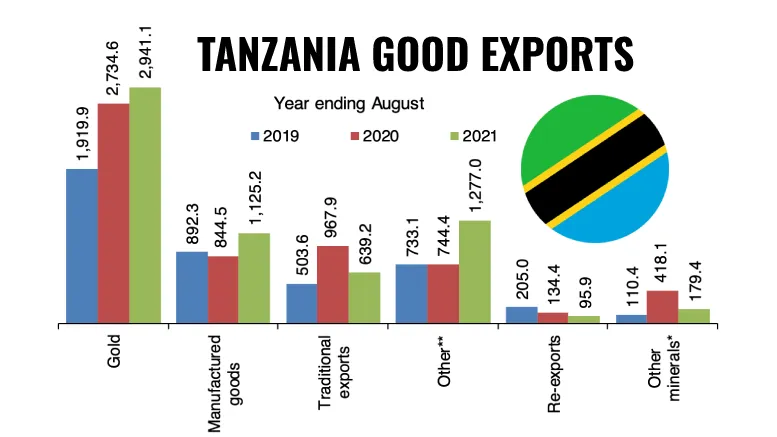
Tanzania’s main exported goods
Tanzania, a country in East Africa, is a significant player in the global export market, particularly in agricultural and mineral commodities. Its economy relies heavily on the export of various goods that contribute to its foreign exchange earnings and economic development. Below is a detailed overview of Tanzania’s main exported goods:
1. Gold
Gold is Tanzania’s leading export product, accounting for a substantial portion of the country’s foreign earnings. Tanzania is Africa’s fourth-largest gold producer, with major mining operations located in regions like Geita, Shinyanga, and Mwanza. Most of the gold is exported to markets in Switzerland, India, and the United Arab Emirates, among others. Gold mining has significantly contributed to Tanzania’s economic growth, attracting foreign investment and creating jobs.
2. Coffee
Tanzania is one of Africa’s notable coffee producers, exporting both Arabica and Robusta coffee varieties. The high-altitude regions of Kilimanjaro and Mbeya are known for their high-quality coffee beans. Coffee exports primarily target markets in Europe, the United States, and Japan. The crop is a major source of income for smallholder farmers and cooperatives in the country.
3. Cashew Nuts
Cashew nuts are another major export commodity, with Tanzania being one of the largest producers in Africa. The southern regions of Mtwara and Lindi are the primary cashew-producing areas. The nuts are exported in raw and processed forms to India, Vietnam, and other Asian countries. Efforts to improve local processing are ongoing to add value and increase export revenue.
4. Tobacco
Tobacco is a significant agricultural export, mainly grown in the Tabora region. The crop is exported to markets in Europe, Asia, and the Americas. Tanzania’s tobacco industry supports thousands of farmers and contributes significantly to the country’s agricultural export earnings.
5. Cloves
The Zanzibar archipelago, part of Tanzania, is renowned for its high-quality cloves. As one of the world’s largest producers, Tanzania exports cloves to India, Indonesia, and the Middle East. The spice trade has been a cornerstone of Zanzibar’s economy for centuries, making it an iconic export product.
6. Cotton
Tanzania’s cotton industry contributes to the country’s textile and apparel exports. Cotton is grown in regions like Mwanza and Shinyanga and is exported as raw cotton and yarn to China, India, and other Asian countries. The government is working to boost the value chain by promoting local textile production.
7. Horticultural Products
Tanzania’s horticultural sector, including the export of fresh fruits, vegetables, and flowers, has been growing rapidly. Products such as avocados, mangos, and green beans are exported to European markets, particularly the Netherlands, Germany, and the UK. This sector benefits from the country’s favorable climate and fertile soils.
8. Minerals
Apart from gold, Tanzania is rich in other minerals like gemstones (e.g., tanzanite, a rare blue-violet gemstone found only in Tanzania), diamonds, and copper. These are primarily exported to countries in Asia, Europe, and North America, contributing significantly to Tanzania’s mining revenues.
9. Fish and Fish Products
Tanzania’s extensive coastline and freshwater lakes, such as Lake Victoria, make fish and fish products an important export. Nile perch and tilapia are particularly popular in export markets, including Europe and the Middle East.
10. Tea
Tea is a traditional export crop grown in regions like Iringa and Njombe. Tanzanian tea is highly sought after for its quality, especially in markets in Pakistan, the UK, and Germany.
Conclusion
Tanzania’s export sector is diverse, spanning agriculture, mining, and fisheries. While the country has made significant strides in boosting export volumes, challenges such as limited value addition and global market fluctuations remain. Efforts to enhance local processing and diversify export markets are crucial for maximizing Tanzania’s export potential and ensuring sustainable economic growth.



Leave a Reply